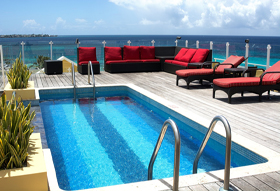
Poolside Foam

If you have ever been to a swimming pool or outdoor lido, chances are that you have encountered a foam product in some capacity. Foam in this setting is used in several applications and tasks, notably to improve comfort and safety. The versatility of polyethylene foam makes it an excellent choice for its many poolside uses.
First and foremost, nearly all of us have come into contact with foam to ensure our safety. For younger children, there has been a boom in popularity for closed-cell polyethylene foam float jackets which are buoyant yet lightweight. However, these life jackets are not just for children - adult versions are just as popular and as effective, and often used in outdoor water for paddle boarding and kayaking. These jackets are usually covered in a soft, durable neoprene fabric that does not affect the quality or buoyancy of the jacket itself. However, it is important to note that float jackets commonly used in poolside settings are not the same as life jackets. Life jackets are designed to keep an individual upright in water, whereas float jackets encourage children and adults to swim. This is why float jackets are frequently used during swimming lessons.
Foam is also found in poolside seating, such as loungers and seats. Usually made from cut to size closed-cell polyethylene foam, it ensures that these seats remain hygienic as they are resistant to the chemicals used to clean them, resistant to mould, mildew, bacteria and are well proofed against general wear and tear. Another material commonly used is Plastazote Superior closed-cell foam due to its water resistant and non-absorbent properties. As Nitrogen-expanded cross-linked closed cell foam, it adopts the same properties of that of standard closed-cell polyethylene and offers additional qualities. These poolside foams - whether used in lounge chairs or standalone seats - are often covered with a vinyl cover that is wipe clean and also resistant to many pool chemicals such as chlorine.

For those with disabilities, foam can make a huge improvement in terms of comfort and helps to make water more accessible to all. For example, poolside hoists traditionally incorporated hammock seating which is then attached to the metal support. However, many find that these hammocks offer limited support and are frequently uncomfortable for those with limited mobility when entering the water. Rigid flat seats are now therefore a popular option, and many of their base seat elements are padded with polyethylene foam. Like the material makeup of poolside lounges and chairs, this same foam – Plastazote superior closed-cell - is a popular choice for pool hoists.
Pool floats are also a popular item encountered at the poolside. From ‘noodle’ floats and water weights to A4 float boards, the versatility of polyethylene foam is represented in its various ‘float’ uses. The natural buoyancy of closed-cell polyethylene makes it perfect for resistance exercises conducted underwater when using water weights, and at the same time, this buoyancy makes for the perfect swimming float.
At eFoam, we are experts in providing polyethylene foams cut to size to fit a range of uses. Our capabilities extend to making fully customized items to meet your requirements. Should you require any assistance, please contact us.

